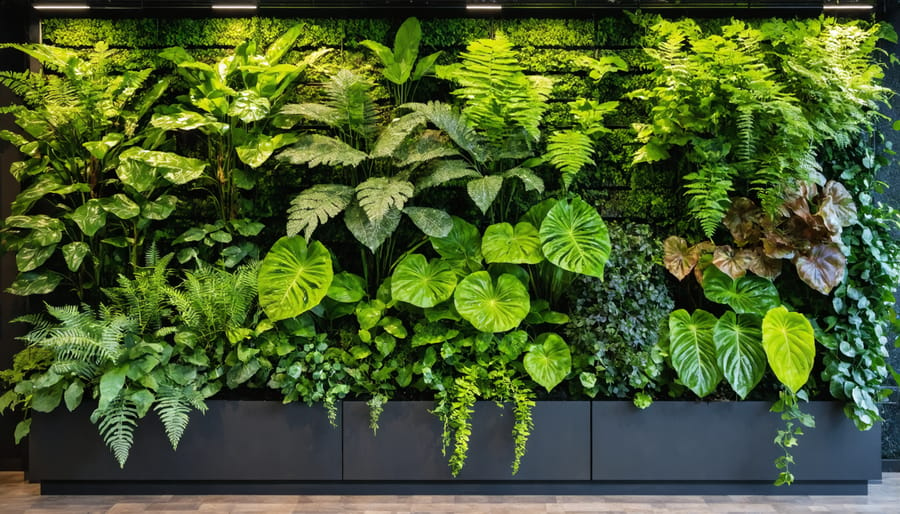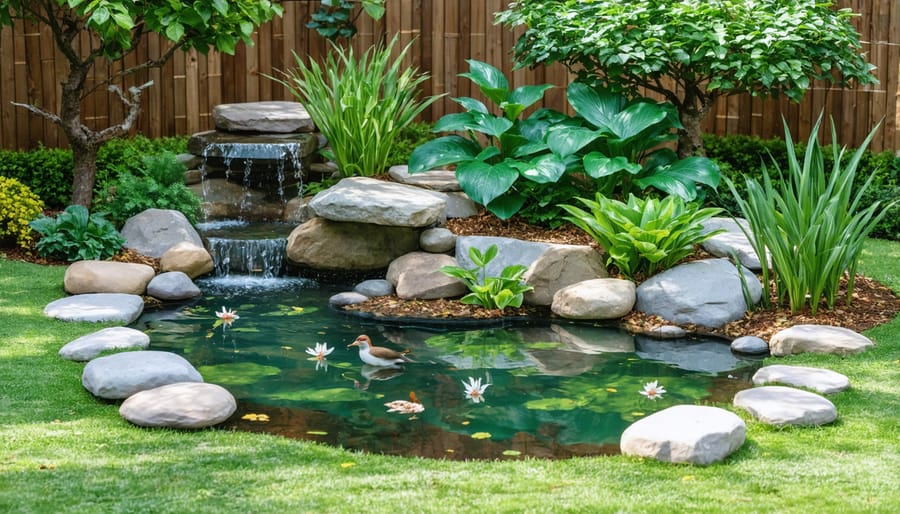Step outside barefoot onto dewy morning grass, letting each blade tickle your toes and ground you to Earth’s natural rhythm. This simple practice begins your journey to creating a peaceful outdoor sanctuary that reconnects you with nature’s healing presence.
Nature’s transformative power lies within easy reach, whether you’re surrounded by sprawling wilderness or limited to a tiny urban balcony. Modern life often divorces us from our innate connection to the natural world, but rediscovering this bond doesn’t require dramatic lifestyle changes or remote retreats.
By weaving small, intentional moments of natural connection into your daily routine, you can tap into the profound benefits of nature exposure – from reduced stress and anxiety to enhanced creativity and mental clarity. These five practical approaches will help you cultivate a deeper relationship with the natural world, regardless of where you live or how busy your schedule may be.
Create a Living Wall Paradise

Selecting Climate-Appropriate Plants
Choosing the right plants for your climate is crucial for creating a thriving vertical garden that connects you with nature. Start by observing your local weather patterns and determining your USDA hardiness zone. For sunny spots, consider drought-resistant options like sedums, herbs, and native flowering plants that attract pollinators. In shadier areas, ferns, moss, and shade-loving perennials work beautifully.
For indoor vertical gardens, tropical plants like pothos, philodendrons, and peace lilies adapt well to controlled environments. Remember to group plants with similar water and light requirements together for easier maintenance. Consider seasonal changes too – some plants may need extra protection during extreme weather.
Pro tip: Visit local nurseries and gardening centers to find plants that naturally thrive in your area. They can offer valuable advice about which varieties will flourish in your specific microclimate and help you create a sustainable, low-maintenance vertical garden that brings nature right to your doorstep.
Installation and Maintenance Tips
Start by selecting a sturdy wall or frame that can support your living wall system. Install a waterproof backing board to protect your wall, then attach a grid system or pocket planters securely. Choose plants that thrive in vertical conditions, like ferns, pothos, or succulents, and arrange them in a pleasing pattern.
For maintenance, water your living wall regularly, checking soil moisture levels twice weekly. Install a drip irrigation system for easier care, especially for larger installations. Trim plants as needed and remove any yellowing leaves promptly. Feed your plants with a balanced, water-soluble fertilizer every month during growing season.
Monitor for pests and treat any issues immediately with natural solutions. Replace plants that aren’t thriving, and adjust watering schedules based on seasonal changes. Clean any drainage channels monthly to prevent water buildup, and inspect the support structure quarterly to ensure everything remains secure.
With proper care, your living wall can flourish for years, bringing nature’s beauty indoors while purifying your air naturally.
Design a Natural Water Feature
DIY Pond Installation
Creating a backyard pond is easier than you might think and offers a wonderful way to attract wildlife to your space. Start by selecting a sunny location away from trees to prevent leaf accumulation. Choose a pre-formed pond liner or flexible pond liner, depending on your desired shape and size.
Dig your hole about 2 feet deep, with graduated depths creating shelves for different types of plants. Ensure the edges are level, then add a layer of sand before placing your liner. Secure the edges with rocks or pavers, leaving some overhanging to create hiding spots for wildlife.
Add aquatic plants like water lilies and oxygenating grasses to maintain water quality. Consider including a small pump for circulation, though it’s not essential for wildlife ponds. Create easy entry and exit points for creatures by placing partially submerged rocks or branches.
Finally, fill with water and wait patiently – frogs, dragonflies, and birds will soon discover their new oasis!

Maintaining Ecological Balance
Maintaining a healthy balance in your water features doesn’t have to be complicated. Start by incorporating a mix of submerged, floating, and marginal plants that naturally filter the water and absorb excess nutrients. Aim for about 60% plant coverage to prevent algae overgrowth. Adding beneficial bacteria helps break down organic matter, while installing a small pump creates essential water movement.
Consider introducing native fish species that eat mosquito larvae and algae – just be careful not to overstock. Keep fallen leaves and debris in check with regular skimming, and avoid using chemical treatments whenever possible. Instead, rely on natural solutions like barley straw or UV clarifiers to maintain water clarity.
Monitor your water quality monthly using simple test strips, and make gradual adjustments as needed. Remember, a balanced ecosystem is self-sustaining, requiring minimal intervention once established. Your reward? A thriving, low-maintenance water feature that attracts wildlife and creates a peaceful atmosphere in your outdoor space.
Build a Wildlife-Friendly Garden
Native Plant Selection
Transform your outdoor space into a thriving ecosystem by embracing eco-friendly garden practices with native plants. These local heroes are perfectly adapted to your region’s climate and soil conditions, making them both beautiful and low-maintenance additions to your garden. Start by researching plants native to your area through local nurseries or botanical gardens. Consider flowering perennials like coneflowers or black-eyed susans, which attract pollinators and create vibrant splashes of color. Native shrubs and trees provide essential shelter for local wildlife while adding structure to your landscape. When selecting plants, think about your space’s specific conditions – sun exposure, soil type, and moisture levels. Mix different heights and blooming seasons to create year-round interest and support diverse wildlife populations. Remember, even a small container garden of native plants on your balcony can make a meaningful contribution to your local ecosystem.
Creating Wildlife Habitats
Transform your outdoor space into a thriving wildlife sanctuary with these simple yet effective habitat features. Start by planting native flowers like echinacea, black-eyed susans, and butterfly weed to attract pollinators. Create a water source using a shallow bird bath or a small pond with varying depths – even a recycled container can work perfectly.
Layer your garden with different heights of plants to provide shelter and nesting spots. Include shrubs like elderberry or viburnum for birds, and leave some brush piles for beneficial insects. Don’t forget to add host plants like milkweed for monarch butterflies and dill for swallowtails.
Install bird feeders with a variety of seeds, and consider adding a hummingbird feeder filled with natural sugar water. Create insect hotels using bamboo tubes, pine cones, and fallen bark to support beneficial bugs. Remember to avoid pesticides and embrace a slightly wild, natural look – it’s exactly what wildlife prefers!

Design Natural Pathways
Material Selection
When selecting materials to enhance your connection with nature, opt for organic elements that bring the outdoors in. Natural wood, like cedar or teak, adds warmth and character while being durable enough for outdoor use. Stone and pebbles create grounding elements perfect for pathways or meditation spaces. Consider incorporating bamboo for its sustainable properties and versatile applications. Living materials such as moss can transform ordinary surfaces into vibrant green features. For textiles, choose natural fibers like cotton, jute, or hemp that weather beautifully and complement outdoor spaces. Remember that raw, unfinished materials often develop a unique patina over time, telling their own story as they age. Mix and match these elements to create layered, sensory-rich environments that feel authentic and inviting.
Layout Planning
When planning your outdoor pathways, embrace natural curves and flowing lines that mirror nature’s organic patterns. Avoid rigid, straight lines in favor of gentle bends that guide visitors through your space naturally. Consider using stepping stones placed at varying intervals to create a more dynamic walking experience, or incorporate gravel paths that meander through garden beds. Take cues from the existing landscape – work around established trees and use natural elevation changes to your advantage. For a cohesive feel, echo the curves of nearby flowerbeds or water features in your pathway design. Remember to plan wider paths in high-traffic areas and narrower ones for more intimate garden spaces. This organic approach not only looks more natural but also encourages slower, mindful movement through your outdoor sanctuary.
Incorporate Natural Materials
Sustainable Material Options
When creating your outdoor sanctuary, choosing eco-friendly materials isn’t just good for the planet—it’s a way to bring authentic natural elements into your space. Consider incorporating reclaimed wood for decking or garden beds, which adds character while giving new life to existing materials. Bamboo is another excellent choice, growing quickly and sustainably while offering durability for various outdoor applications. For pathways and hardscaping, opt for permeable materials like gravel or recycled pavers that allow water to naturally filter into the ground.
Looking for sustainable outdoor furniture options? Natural materials like teak from certified sources, recycled plastic lumber, and weather-resistant bamboo furniture provide both durability and environmental benefits. For smaller elements, consider cork, jute, or reclaimed metal accessories that weather beautifully while minimizing environmental impact. These materials not only create a more sustainable outdoor space but also help maintain a genuine connection to nature through their organic textures and appearances.
DIY Natural Projects
Get your hands dirty with these engaging DIY projects using natural materials. Create a rustic centerpiece by arranging pinecones, dried leaves, and twigs in a repurposed mason jar. Try pressing wildflowers between heavy books to make beautiful botanical artwork – just ensure the flowers are completely dry before framing them.
For a more substantial project, build a natural twig picture frame by collecting fallen branches and securing them with twine. Children especially love creating fairy gardens using moss, small stones, and tiny plants in a shallow container. These miniature landscapes spark imagination while connecting with nature.
Consider crafting your own natural bird feeder by threading berries and dried fruit onto twine, or hollow out oranges to fill with bird seed. These simple projects not only bring nature closer but also provide a sense of accomplishment and create lasting decorative pieces for your home.
Transforming your outdoor space into a natural sanctuary doesn’t have to be overwhelming or expensive. By implementing these five strategies – creating a wildlife-friendly garden, establishing meditation spaces, incorporating water features, designing sensory pathways, and building natural gathering areas – you can create a meaningful connection with nature right at home.
Remember, you don’t need to tackle everything at once. Start with what resonates most with you, whether it’s planting native species to attract local wildlife or setting up a simple meditation corner with comfortable seating and calming elements. Each small step brings you closer to a more nature-connected lifestyle.
The key is to make your outdoor space work for your specific needs while honoring the natural environment. As you implement these ideas, you’ll likely discover additional ways to enhance your connection with nature. Be patient with the process and enjoy watching your space evolve into a living, breathing ecosystem that provides both refuge and inspiration.
Take the first step today – even something as simple as adding a bird feeder or placing a comfortable chair in a peaceful corner can begin your journey toward a more nature-integrated lifestyle. Your future self will thank you for creating this special connection with the natural world.
